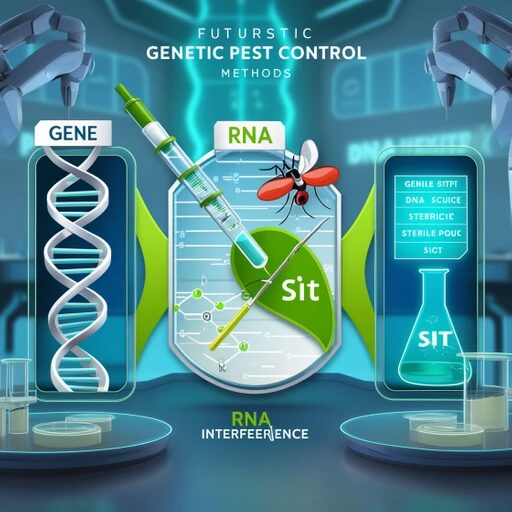The idea of spending money only to introduce health risks into your home is troubling. Traditional pest control methods, while effective, often come with a price not just for your wallet but for your health as well.
When pests invade your home, it’s natural to seek out ways to eliminate them. However, your top concern should be whether these pest control methods are safe and free from harmful health effects.
This is where Genetic Pest Control Methods offer a solution. These innovative approaches are eco-friendly and pose no threat to your health, providing peace of mind while effectively managing pests.
Genetic pest control methods involve the use of genetic technologies to control or terminate pest populations by altering their biological processes. These methods aim to reduce the need for harmful chemical pesticides by targeting pests at the genetic level.
Key Types of Genetic Pest Control Methods

Gene Drives: This technique spreads specific genetic traits, such as sterility or disease resistance, throughout pest populations, ensuring these traits are passed down to the majority of offspring.
Sterile Insect Technique (SIT): This method involves releasing sterile male insects into the environment, which then mate with females but produce no offspring, gradually reducing the pest population.
RNA Interference (RNAi): RNA interference targets specific genes in pests, disrupting vital functions like reproduction or feeding, effectively controlling the pest without impacting other species
Benefits of Genetic Pest Control
Genetic pest control offers a range of significant advantages over traditional pest management methods, making it an attractive alternative for environmentally conscious consumers. Here are some key benefits:
1. Environmentally Friendly with Reduced Chemical Use
One of the most significant advantages of genetic pest control methods is their potential to minimize or eliminate the reliance on harmful chemical pesticides.
Traditional pesticides can contaminate soil, water, and air, posing risks to human health and non-target species. By reducing chemical use, genetic pest control helps preserve biodiversity and maintain healthy ecosystems.
This approach aligns with the growing demand for sustainable agricultural practices, ensuring that pest management contributes positively to the environment.
2. Highly Targeted, Affecting Only Pest Species
Genetic pest control methods are designed to be species-specific. Unlike broad-spectrum chemical pesticides that can indiscriminately harm beneficial insects, such as pollinators and natural pest predators, genetic techniques primarily affect the target pest species.
For example, gene drives can be engineered to target only specific types of mosquitoes, reducing the population without impacting other insects. This targeted approach helps maintain ecological balance and protects vital species within the ecosystem.
3. Long-Term Pest Control Effectiveness
Many genetic pest control strategies, such as gene drives and the Sterile Insect Technique (SIT), offer sustained pest control effects over multiple generations.
By introducing genetic modifications that spread through pest populations, these methods can provide a long-term solution to pest problems, reducing the need for frequent applications or interventions.
This not only saves time and resources but also promotes more effective and efficient pest management.
4. Lower Risk of Pest Resistance Compared to Pesticides
A major challenge with traditional chemical pesticides is the development of resistance among pest populations. Over time, pests can adapt to these chemicals, rendering them ineffective and leading to a cycle of increased pesticide use.
In contrast, genetic pest control methods disrupt vital biological processes within the target species, making it much harder for pests to develop resistance. For instance, RNA interference (RNAi) targets specific genes essential for pest survival, which pests cannot easily adapt to.
This lowers the risk of resistance and ensures the continued effectiveness of pest control efforts.
Challenges and Ethical Concerns
While genetic pest control methods offer promising solutions to pest management, they also present several challenges and ethical concerns that must be addressed. Here are some of the issues:
1.High Costs and Implementation Challenges
Developing genetic pest control methods can be costly and resource intensive. The research and development phase requires significant investment, including funding for field trials, regulatory compliance, and public outreach efforts.
Additionally, the implementation of these technologies in agricultural settings may face logistical challenges, such as the need for specialised training for pest control professionals and farmers.
For many small-scale farmers, the upfront costs and complexities associated with adopting genetic pest control methods may be prohibitive, limiting widespread adoption.
2. Public Concerns About Genetic Modification
Genetic modification often raises concerns among the public, particularly regarding its safety and long-term impacts.
Many consumers are wary of genetically modified organisms (GMOs) due to fears of unforeseen consequences, such as potential health risks or ecological disruptions.
This doubt can hinder the acceptance of genetic pest control technologies, even when research indicates their safety and efficacy.
To overcome this barrier, it is essential for scientists, policymakers, and advocates to engage with the public, providing transparent information and addressing misconceptions about genetic modification.
3. Ethical Considerations of Altering Ecosystems
The prospect of changing the genetic makeup of living organisms raises profound ethical questions. Critics argue that genetic pest control methods could inadvertently disrupt ecosystems, leading to unintended consequences that may harm non-target species or alter food webs.
For instance, the introduction of gene drives in natural populations could have far-reaching effects on ecological balance. It is crucial to thoroughly assess the potential ecological impacts and establish appropriate regulatory frameworks to ensure that genetic interventions do not compromise the integrity of ecosystems.
This requires collaboration among scientists, ethicists, and policymakers to evaluate the risks and benefits of these technologies.
Conclusion
Genetic pest control methods present a transformative approach to pest management, offering numerous advantages over traditional chemical pesticides.
Their environmentally friendly nature, targeted effectiveness, long-term pest control potential, and lower risk of resistance make them a compelling option for sustainable pest management.
As we reflect on the future of pest control, it is clear that genetic methods hold significant promise as part of an integrated pest management (IPM) system.
By combining these innovative techniques with other pest control strategies, we can create a more effective and sustainable approach to managing pest populations.